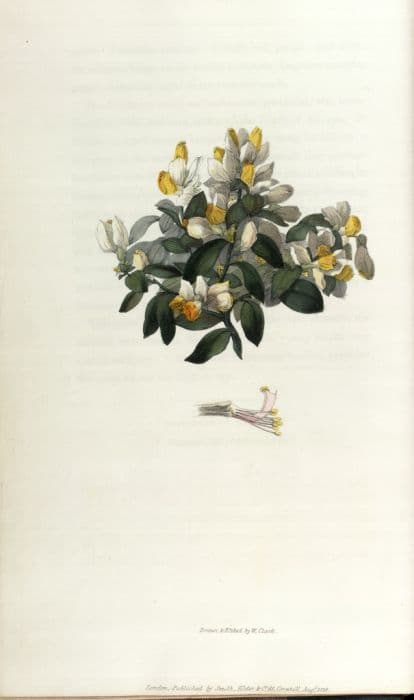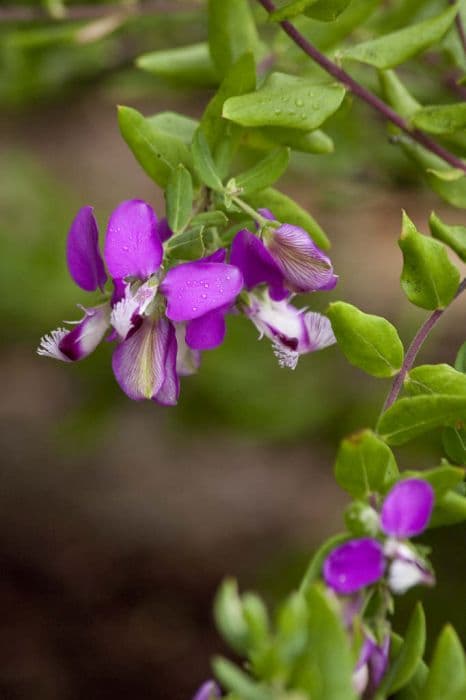Shrubby Milkwort Polygaloides chamaebuxus

ABOUT
The plant known commonly as Box-leaved Milkwort is a small, evergreen shrub that has a dense and bushy appearance, typically forming mats or low mounds. It bears shiny, dark green leaves that are opposite, oval to oblong in shape, and somewhat resemble those of the boxwood, hence its common name. During the blooming period, which occurs in spring and sometimes again in autumn, it displays attractive flowers. The flowers are unique, with two large, petal-like sepals framing smaller, intricate petals and a central keel, often in contrasting colors. The typical color combination is yellow and purple, with the larger sepals being yellow and the inner petals usually purple, white, or sometimes a creamy yellow. After flowering, it produces small fruit capsules. The overall impression of the Box-leaved Milkwort is of a neat, compact plant that adds a splash of color and evergreen structure to the garden setting.
About this plant
 Names
NamesSynonyms
Shrubby Milkwort, Box-Leaved Milkwort, Box Milkwort, Dwarf Milkwort, Shrubby Polygala, Eternal Flame.
Common names
Polygala chamaebuxus, Polygala chamaebuxum.
 Toxicity
ToxicityTo humans
Commonly known as the box milkwort, Polygaloides chamaebuxus is not widely documented as a toxic plant to humans. However, as a general precaution, plants that are not typically consumed as food should be considered potentially hazardous if ingested. Some plants in the Polygala family are known to contain saponins and other compounds that may cause adverse effects such as gastrointestinal discomfort. If someone ingests box milkwort and experiences symptoms such as nausea, vomiting, diarrhea, or other concerning reactions, medical attention should be sought.
To pets
The box milkwort, Polygaloides chamaebuxus, does not have a well-established record of toxicity in pets. However, pets may have sensitivities that humans do not, and plants like box milkwort that are not generally recognized as edible could potentially cause mild to moderate digestive upset. If a pet ingests part of this plant, watch for symptoms such as vomiting, diarrhea, or unusual lethargy, and consult a veterinarian if such signs occur or if you have concerns about your pet's health after ingestion.
 Characteristics
CharacteristicsLife cycle
Perennials
Foliage type
Evergreen
Color of leaves
Green
Flower color
Yellow
Height
1 foot (0.3 meters)
Spread
2 feet (0.6 meters)
Plant type
Shrub
Hardiness zones
5
Native area
Europe
Benefits
 General Benefits
General Benefits- Ornamental value: Polygaloides chamaebuxus, commonly known as Shrubby Milkwort, is appreciated for its vibrant and colorful flowers which add aesthetic beauty to gardens.
- Drought tolerance: Being a resilient plant, it requires minimal watering once established, making it suitable for xeriscaping in arid climates.
- Low maintenance: Shrubby Milkwort requires little care once it is established, making it an easy plant to maintain for gardeners of all skill levels.
- Ground cover: The low-growing nature of Shrubby Milkwort allows it to spread across the ground, suppressing weeds and reducing soil erosion.
- Cold hardiness: This plant is tolerant to cold temperatures, making it suitable for planting in regions with harsh winters.
- Wildlife attraction: The flowers of Shrubby Milkwort can attract butterflies and pollinators, contributing to biodiversity in the garden.
- Compact size: Due to its small size, it is suitable for gardens with limited space or for use in rockeries and alpine gardens.
 Medical Properties
Medical PropertiesThis plant is not used for medical purposes.
 Air-purifying Qualities
Air-purifying QualitiesThis plant is not specifically known for air purifying qualities.
 Other Uses
Other Uses- Polygaloides chamaebuxus, commonly known as Box-leaved Milkwort, can be used as ground cover in rock gardens or alpine gardens due to its low-growing, spreading habit.
- The evergreen foliage of Box-leaved Milkwort adds winter interest to the garden, providing greenery when most other plants have died back or become dormant.
- Box-leaved Milkwort's dense growth can be beneficial for preventing soil erosion on slopes or in areas where ground stabilization is needed.
- The plant is sometimes used in floral arrangements, especially in winter, because its leaves and occasionally its flowers persist through colder months.
- In landscaping, Box-leaved Milkwort can be used to create intricate patterns or designs as it can be clipped to maintain a desired shape.
- Box-leaved Milkwort may be planted along the edges of paths or walkways as a decorative border due to its compact growth habit.
- The distinct flowers of Box-leaved Milkwort can attract pollinators like bees and butterflies, making it a useful addition to support local ecosystems.
- Due to its hardiness and adaptability, Box-leaved Milkwort can be utilized in restoration projects, particularly in rocky or poor soil conditions where other plants might not thrive.
- Box-leaved Milkwort can be used in container gardens or small spaces, as it does not require much room to spread and can be quite ornamental.
- The contrast between the dark green leaves and bright flowers of the Box-leaved Milkwort is sometimes used by gardeners to create visual drama in garden compositions.
Interesting Facts
 Feng Shui
Feng ShuiThe plant Shamrock is not used in Feng Shui practice.
 Zodiac Sign Compitability
Zodiac Sign CompitabilityThe plant Shamrock is not used in astrology practice.
 Plant Symbolism
Plant Symbolism- Persistence: The Polygaloides chamaebuxus, commonly known as Box-leaved Milkwort, typically grows in alpine and subalpine areas, where conditions can be harsh. Its ability to thrive in difficult environments signifies persistence and the capacity to endure challenges.
- Protection: As Box-leaved Milkwort is related to the box plant, which has been historically used for protective hedges, it can symbolize the idea of creating boundaries and safeguarding one's space.
- Versatility: This plant's adaptability to different soil types and positions in the garden represents versatility and the idea of being adaptable in life.
 Water
WaterShrubby Milkwort should be watered regularly but moderately, ensuring the soil is kept moist without becoming waterlogged. During the growing season, it may need watering once every week, with about 1 gallon per plant, depending on the climate and soil drainage. In the winter, water less frequently, allowing the top inch of soil to dry out between waterings. Be careful not to overwater as this plant is susceptible to root rot, particularly in poorly draining soils.
 Light
LightShrubby Milkwort thrives in full sun to partial shade conditions. The ideal spot for this plant is one where it can receive at least four to six hours of sunlight each day, though it can tolerate some light shade. Avoid deep shade, as this will reduce flowering and can lead to leggy growth.
 Temperature
TemperatureShrubby Milkwort prefers a temperate climate and can tolerate a temperature range from around 20°F to 75°F. The ideal temperature for this plant is between 60°F and 70°F. It can survive brief periods of colder temperatures down to 20°F but sustained cold or frost may damage the plant.
 Pruning
PruningShrubby Milkwort benefits from light pruning to maintain its shape and encourage bushier growth. Prune after the plant has finished flowering, typically in late spring or early summer. Cut back any weak or dead stems and remove faded flowers to promote new growth. Pruning can be done annually or as needed to keep the plant tidy.
 Cleaning
CleaningAs needed
 Soil
SoilPolygala chamaebuxus, commonly known as Shrubby Milkwort, prefers well-draining soil with a slight acidic to neutral pH, around 5.5 to 7.0. A standard mix of two parts peat or coir, one part perlite or sand, and one part garden loam or compost works well. Ensure good drainage to prevent root rot.
 Repotting
RepottingShrubby Milkwort should be repotted every 2 to 3 years or when it has outgrown its current pot. This slow-growing plant enjoys being slightly root-bound, so avoid choosing a much larger pot.
 Humidity & Misting
Humidity & MistingShrubby Milkwort is tolerant of average humidity levels and does not require high humidity to thrive. It performs well in the typical humidity found in most homes without the need for special adjustments.
 Suitable locations
Suitable locationsIndoor
Place in bright, indirect light and keep soil lightly moist.
Outdoor
Plant in partial shade, well-draining soil and shelter from harsh winds.
Hardiness zone
5-9 USDA
 Life cycle
Life cyclePolygaloides chamaebuxus, commonly known as the shrubby milkwort, begins its life cycle as a seed, which germinates in favorable conditions of moisture and temperature. Once sprouted, the seedling establishes itself and develops into a juvenile plant with characteristic trifoliate leaves. As it matures, the shrubby milkwort enters the vegetative stage, forming dense, low mounds of evergreen foliage. The plant reaches reproductive maturity and flowers in early to late spring, with its bloom featuring small, yellow-centered, purple flowers, which are often pollinated by bees and other insects. Following pollination, the flowers develop into small capsules containing seeds that disperse to propagate the next generation. The shrubby milkwort can live for several years, and while it is perennial, it may enter a dormancy phase during the cold winter months before re-emerging in the spring.
 Propogation
PropogationPropogation time
Spring
The most popular method of propagation for the plant known as Polygaloides chamaebuxus, commonly called Shrubby Milkwort, is through semi-ripe cuttings. This technique is typically done in summer when new growth has partially matured but still retains some flexibility. Cuttings of 4 to 6 inches (approximately 10 to 15 centimeters) are taken and the lower leaves are removed. A rooting hormone can be applied to the cut end before planting it into a well-draining potting mix. The cutting should then be placed in a warm, humid environment with indirect sunlight to encourage root development, which could take several weeks. Covering the pot with a plastic bag can help maintain humidity levels, but it should be opened regularly to prevent mold growth. Once rooted, the new plants can be gradually acclimatized to normal conditions before planting out.

